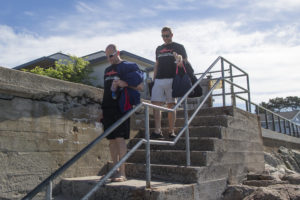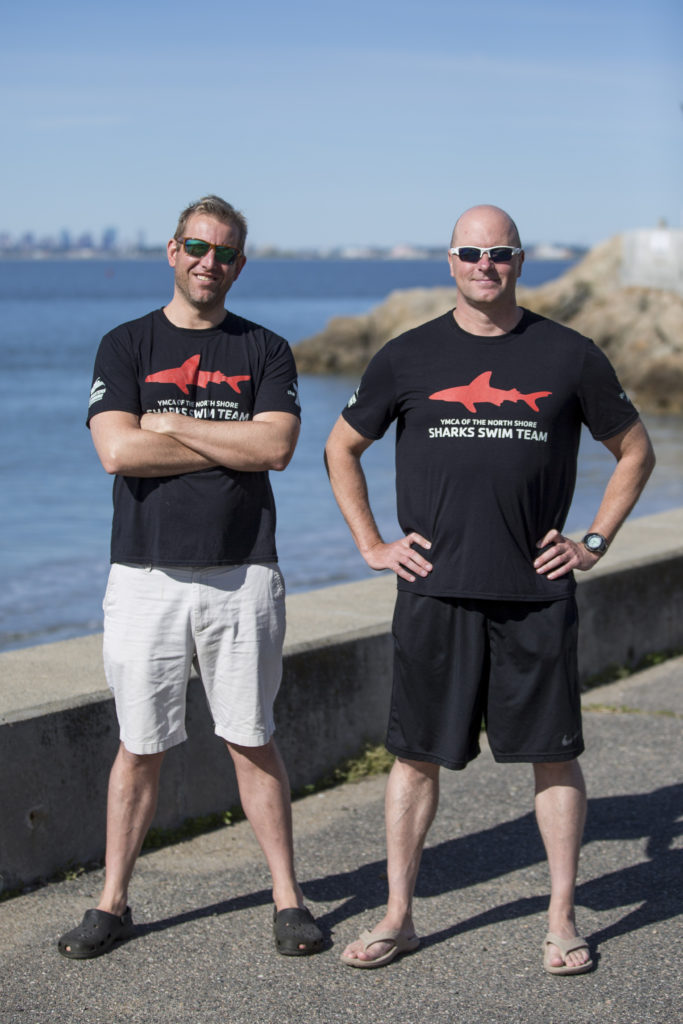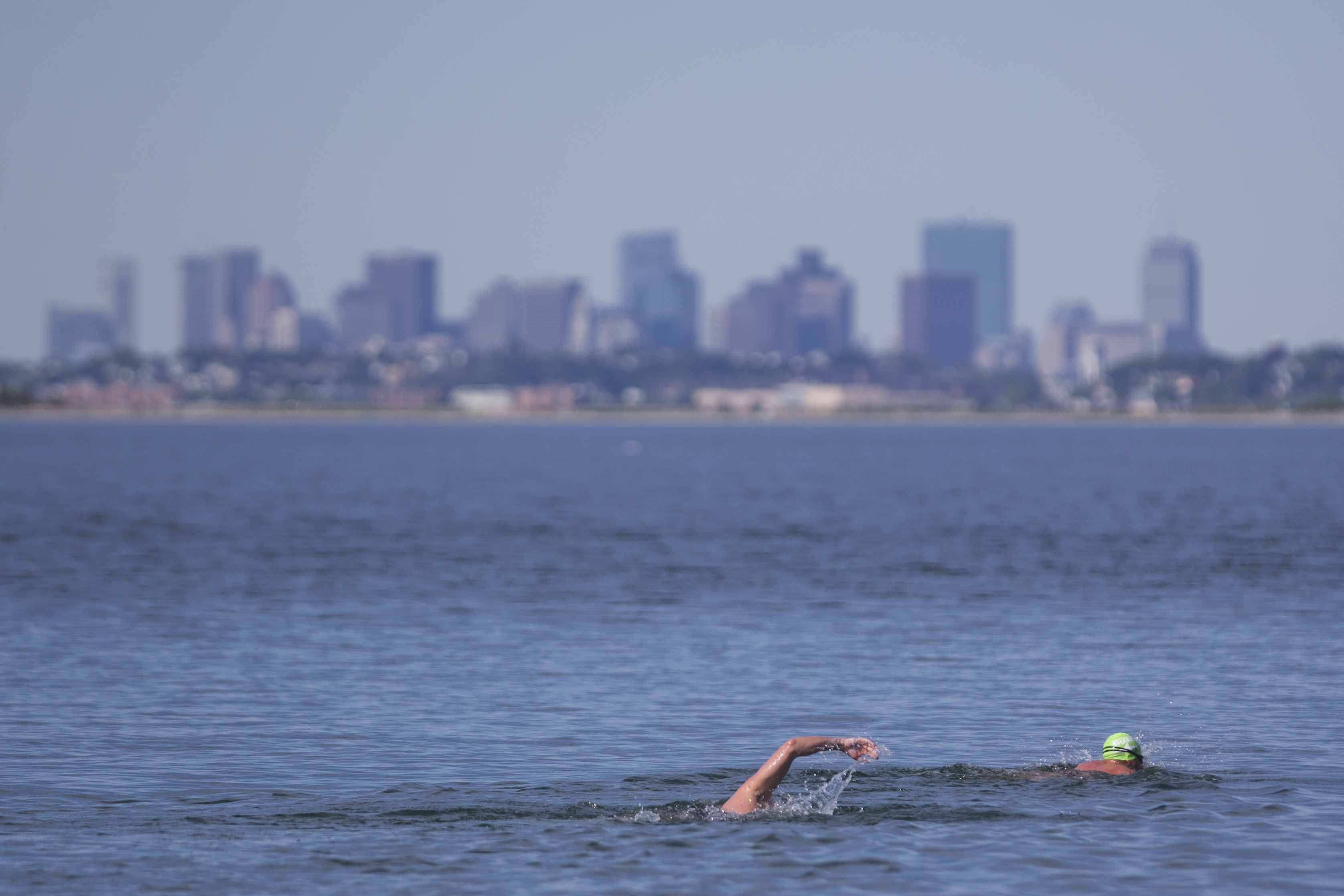Swampscott men tackle the ‘Mount Everest of swimming’
By MEAGHAN CASEY
There will likely be jellyfish, water temperatures dipping below 60 degrees, salt-water induced swelling of lips and tongues, skin chafing and stretches of hunger and fatigue, but that won’t stop Swampscott’s Andy Jones and Tommy Gainer from attempting to swim the English Channel this summer.
You’re going to be uncomfortable. You’re going to be cold. You’re going to get stung,” said Jones. “That’s about 20 percent of the challenge. The rest is mental.”
“I try to focus on the sound of the water, the feel of the water and my breathing,” he continued. “It’s almost like meditation.”
“Night swimming will be an odd experience,” said Gainer. “I’ll have to get used to the solitude of being alone in the water, with just a boat next to you. You can scare yourself silly, but you have to just focus on what’s ahead.”

Since the first observed and unassisted swim in 1875, fewer than 1,800 swimmers have successfully completed solo swims across the 21 miles that separate Shakespeare Beach in Dover, England, from Cap Gris Nez in France. Due to the currents and tides, swimmers tend to tackle more of an S-shaped course, making the distance greater. On top of that, the Channel is one of the busiest shipping lanes in the world, with an average of 600 tankers and 200 ferries passing through every day. Swimmers often have to stop and tread water or alter their paths.
“I can deal with everything else, but the idea of swimming close to a really big ship freaks me out,” said Gainer.
“For good reason, this is known as the Mount Everest of swimming,” said Jones. “‘Nothing great is easy’ is inscribed on the memorial of Captain Matthew Webb, the first person to swim the Channel.”
Registered through the Channel Swimming & Piloting Federation (CS&PF), Gainer is scheduled to swim at some point between July 29 and August 6. Jones will follow him, during the week of August 7. There’s a small chance the pair will swim during the same week if weather conditions were to bump Gainer from his slot.
An assigned pilot and an observer will be alongside them throughout the course, but the swimmers are responsible for all aspects of their own safety.
“If you touch the boat or if anyone touches you, you’re disqualified, so you have to be really alert about that,” said Jones, explaining the only thing they can have contact with is a feeding bottle attached by a line to the boat.
Gainer and Jones, who ironically live within a stone’s throw of each other, met while swimming with the YMCA of the North Shore Sharks Masters Swim Team.
Jones, born and raised in England, moved to the United States in 2003 to expand the operations of Stroud International, which he co-founded. After living in the North End of Boston for a couple years, he and his wife, Jacqueline, moved to Swampscott in 2006. The couple has two sons.
Gainer, who grew up in Newport News, Va., moved with his wife, Lindsay, from North Carolina to Boston in 2007 after accepting a job with Invitrogen. They’ve lived in Swampscott since 2009 and have two young daughters.
“We’re beach people, so we made a lot of trips to the North Shore,” he said. “It was the right move. We fell in love with the area.”
Both men have had a natural inclination to the water from a young age. 
“I’ve always been in the water,” said Gainer. “My mother started me on swimming lessons at 6 months.”
He began swimming competitively year-round in elementary school. At age 17, he picked up surfing, and in college and graduate school, he worked as a lifeguard and swim instructor.
After college, Gainer switched gears and started running. He had just finished one marathon in Nashville, Tenn., and was training for a second when he suffered a tibial stress fracture. With running off the table, he returned to swimming and started competing with the U.S. Masters Swimming at the University of North Carolina. He later joined the Charles River Masters in Cambridge and also swam with a group at Walden Pond in the summers. It was during that time that Gainer was asked to join a relay team for the Boston Light Swim. The oldest open water marathon swim in the U.S., the 8-mile swim has been a local tradition since 1907. Participants begin the race at Boston Light on Little Brewster Island and the course continues past George’s Island and Rainsford Island, then along Long Island and around Thompson’s Island. Swimmers come ashore at the L Street Bathhouse in South Boston. Many cold-water swimmers use this event to prepare for an English Channel crossing.
“That’s really what got me into cold, open-water swimming,” Gainer said. “A few people in the club were training for the Channel at the time and I guess you could say a seed was planted. It became something on my bucket list.”
Following his move to Swampscott, he began swimming between Swampscott and Nahant with a group training for Boston Light. Calling themselves the “Nahant Knuckleheads,” they’d often swim laps on Sundays from the Tides Restaurant to where Mission on the Bay is now and take ocean plunges throughout the year.
“It was all about getting acclimated to the water,” said Gainer. “We’d go on routine dips, starting on New Year’s Day, no matter how cold it was. When you live this close to the ocean, you have to take advantage of it.”
Jones had a slightly different route, admitting he was in inflatable armbands in the water until age 9 and was jealous of his peers taking swim lessons. His parents eventually signed him up for lessons and it turned out he was a natural.
“When I was about 10 or 11, I figured out I had an instinctual feel for the water,” he said. “I remember at that time someone telling me, ‘You’ll swim the Channel someday.’ I’ve never forgotten that. Very few people had done it in the ’70s and ’80s and it was one of those challenges that was always in the back of my mind.”
He swam competitively during his youth and was a member and then captain of the swimming and water polo club at Cambridge University, earning a prestigious blue blazer. After college, his busy career and travel schedule kept him out of the water, but he would pop over to the local outdoor pool when he moved to Boston and later discovered and joined the Sharks. He’s also a member of the coaching staff at the YMCA’s Lynch/van Otterloo branch.
In January 2016, Jones decided to take a sabbatical from work and begin training for the Channel swim.
“It’s eaten away at me all my life, like having a little cartoon mini me on each shoulder whispering in my ears that I can or can’t do it,” said Jones. “If I don’t attempt it now, I know I’ll have regrets.”
Jones was quick to bring on board Gainer, who had previously talked him into doing the 10-mile Northeast Kingdom swim in Vermont, as well as Boston Light.
“I turned the table on him and signed up for the Channel, hoping he’d follow me,” said Jones.
“I didn’t even have to think,” said Gainer. “To have someone to train with, it’s been the perfect time to do it.”
Jones’ wife, who completed an Ironman Triathlon shortly before they were married, was supportive, as was Gainer’s family. In April of that year, Jones completed his qualifying swim in the waters of Mallorca, one of Spain’s Balearic Islands. SwimTrek was hosting an intensive open-water training camp and the CS&PF needs a recorded swim of at least six hours in waters 61 degrees or colder. Gainer completed his qualifying swim during a double Boston Light Swim in October.
Unfortunately, Jones has met a few challenges along the way. Not long after he started training, he got the diagnosis that his left hip had reached the end of its useful life and the muscle spasms around it were crushing the nerves in his leg and lower back.
“It was crippling,” he said. “It was the only time in my life that I could conclusively circle the 10 as my level of pain.”
He was told he needed a total hip replacement, and with that, dreams of the Channel started to crumble. Luckily, he was scheduled for surgery in October with a surgeon who had invented a less-invasive procedure that would allow him to maintain an active lifestyle after rehab. There were, however, complications that lead the hip to dislocate before Jones awoke from the anesthetics and he had an emergency revision surgery days later.
“For weeks I was exhausted and healing took much longer due to the additional trauma,” said Jones. “In December, I rejoined the Sharks but it was too much, too fast. My right shoulder developed tendonitis and, more painfully, so did my new hip. It was one hell of an emotional roller coaster.”
He spent January focused on rehab and started to swim again in February. He did another qualifying swim at the training camp at Mallorca in April to make sure he was ready.
“Unlike last year’s rough water, lack of sun and so many jellyfish, we got ‘Tommy conditions’ this year,” joked Jones, who seems to have been cursed by Mother Nature in comparison to the calm seas and sun that Gainer has perpetually been dealt.
Unfortunately for Jones, old patterns might come back to haunt him during the Channel.
“It’ll be a fierce crossing for me,” he said. “I put myself on the spring tide.”
The preferred time for swims to take place is on what’s called the neap tide, because the period before the tide turns is much longer and the tidal flow is much slower. A pilot will generally schedule one swim during a spring tide and four during a neap tide. Gainer is scheduled during the week when the tides turn from neap to spring, so he may luck out if he starts early.
“Most people feel it’s a more direct shot into France on that tide,” said Gainer. “The pilot will try to get everybody through during neap, but has time reserved the following week if need be. I’ve already taken the three weeks off, so I’m willing to go out at any time.”
Jones and Gainer have progressed from strength-building and dry-land cardio training to pool interval training and long-distance beach swims. Jones says he likes to swim off of Phillips, Preston, Nahant and Devereaux beaches.
“We’re lucky that the water temperatures here are comparable to the Channel conditions,” he said. “I can’t even swim in a backyard pool anymore without feeling overheated.”
While the water might seem chilly enough to send most of us running after dipping a toe in, Jones and Gainer are prepared for the long haul.
“Your body is able to cope with it and retain warmth if you train for it,” Jones continued. “It’s not pleasant at first, but then it becomes tolerable and then you’re just used to it. Getting in is the worst bit, but that’s a universal truth in any swim competition. After the first 300 yards, it’s great.”
The longest swim they’ll likely do prior to heading to England is 10 hours, just to practice getting over the 7-hour barrier when the body typically switches over to fat-burning.
“Once your energy reserves take over and you transition from carbs to fat, your body starts feeling drained,” said Gainer, who would love to set a goal of 12 hours to cross, but his main priority is just finishing. “You have to recognize that point and keep pushing yourself.”
Gainer says his youngest daughter will routinely start singing the song “Just Keep Swimming” from “Finding Nemo” and he’ll no doubt bring that to mind to provide some added motivation while he’s out there.
They’ve both gotten advice from Winthrop resident Kim Garbarino, another member of the YMCA of the North Shore, who crossed the Channel five years ago and who completed a nonstop, 24-hour swim to raise funds for the YMCA three years ago.
“Whenever we get discouraged or overwhelmed, I’ll ask, ‘WWKD? What would Kim do?’” said Jones. “Kim would get off his backside and swim.”
They’ve also connected with Elaine Howley of Waltham and Maura Twomey of Jamaica Plain, who were both successful in their crossings.
At the end of all of this, Jones and Gainer hope to serve as inspiration to another generation of swimmers.
“It’s sets a good example for my own children and the kids I coach,” said Jones. “Setting a goal and working toward achieving it is a great way to approach life. You’re always going to have choices to quit or push on.”
“Nothing is too big to tackle,” said Gainer. “If you put the time and effort in, you can achieve it.”
Gainer is looking forward to some much-deserved sleep and a big meal after the swim.
Jones says he would someday like to accomplish the triple crown, adding the Catalina Channel and the swim around Manhattan to the list, but any plans for that will be on hold until he’s physically ready. After this swim, it’s looking like his right hip will also need surgery. He won’t rest until he’s able to cross this one off the list.
“If I’m unlucky, I’ll definitely do it again,” he said. “If I fail physically, I’ll need to figure out what happened and correct it.”
Here’s hoping for “Tommy conditions” for them both.
Photos: Scott Eisen

